|
Geneva, March 16 1961... the star of the Auto show is unveiled to the
world and the world of sports car will be marked forever... Its name is
the Jaguar E-type, or XKE as it will be better known in the United States,
and it is not only stunning but it also sets new standards in terms of
performance and price.
The early 60s were a time where most cars had drum brakes, live rear
axle, styling still drawing heavily on the 50s, body on frame construction
and performance that was often not so sporty. In contrast Jaguar brought
to Geneva a 150 mph race bred monocoque sports car with independent rear
suspension, disc brakes and styling that would become an icon of the 60s.
In pure Jaguar tradition the price was as spectacular as the performance,
£2,097 for the roadster which was almost half what its nearest competitor
the Aston Martin DB4 sold for ( £3968 ). Yes, it is probable that
if James Bond had been paying for his cars himself rather than the British
government he would have indeed been driving an E-type... Seriously, on
the all important US market, the XKE would be significantly cheaper that
the Corvette, by almost 30 %.
The way the E-type was launched at Geneva is unique and dramatic in many
ways. First, inside the show itself, a fixed head coupe was revealed to
the press and VIPs by lifting up a huge crate which was covering the car,
officially revealing to the word the most advanced sports car ever built.
Then there is the second car, the press demonstrator, which was driven
… yes driven… from Coventry to Geneva and arrived just in time
to be quickly cleaned and presented to the press at a park. What a leap
of faith to send an all new car on a 600 miles journey with only hours
to spare…Jaguar founder Sir William Lyons was on hand to personally
demonstrate the car; incidentally he was known to prefer the styling of
coupe to the convertible which may explain why both Geneva show cars were
coupes.
Three red roadsters... three personalities :
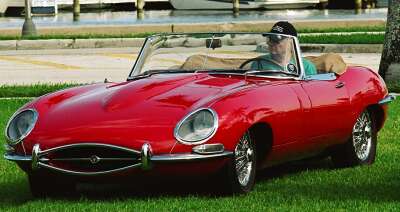
Series 1 : covered headlights, smaller
bonnet opening, turn signals above the bumpers.
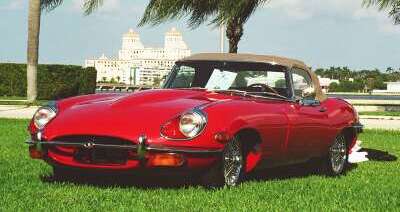
Series 2: open headlights, large bonnet
opening, larger turn signals below the bumpers; still narrow track
and 5" wire wheels.
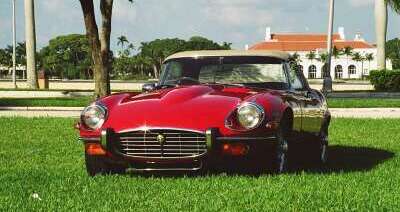
Series 3: fender flares to accommodate
the wider track and 6" wheels, radiator grille, lower air
scoops and longer wheelbase.
|
Work on the E-type had started in the late fifties as a replacement to
the successful XK 120 - 150 series and drew heavily on Jaguar's Le Mans
winning D-type monocoque and front sub frame construction. Mechanically,
the E-type used the same 3.8 liter XK inline 6 cylinder engine with triple
carburetors used on the XK150S developing 265 hp. One of the new features
was the development of an all new independent rear suspension, self contained
in a sub frame, and featuring 4 shocks and springs with inboard disc brakes,
mounted near the differential therefore reducing unsprung weight. This
independent rear suspension system gave Jaguar an edge in term of handling,
comfort, grip and noise. The basic design remained in use not only during
the entire E-type production but would also be found on saloons like the
XJ6 all the way until 1988. The front and rear Dunlop disc brakes were
activated by twin master cylinders providing ample braking power by 1961
standards and reliability. The rack and pinion steering helped give the
E-type its agile reputation with a short turning radius and light efforts.
Another innovation was a separate header tank and the electrical cooling
fan system, which would need improvement in the following years.
The elegant body shape, designed by aerodynamicist Malcom Sawyer, was
a key element in achieving the magic 150 mph top speed. And 150 mph is
something the E-type was capable of, as tested by the British motor press
even though the car used was slightly optimized to reach the magic number
with little details such as the front bumper overriders removed to reduce
aerodynamic drag. Acceleration was impressive as well with Autocar magazine
report 0 to 60 mph times of just under 7".
13 years before, in 1948, Jaguar had stunned the world by producing a
120 mph car, the XK120, something unheard of at the time. Original reaction
to the car was such that Jaguar was not ready to mass produce it and it
would take 2 years to finally create the tooling needed to produce the
steel body instead of the hand made aluminum panel used on the early car.
History would nearly repeat itself with the E-type which was also expected
by Sir Lyons and his team to be a limited production car, that is of course
until the world discovered it in Geneva.
Originally, the company producing the panels, Abbey Panels, was using
concrete tooling rather that steel to produce the panels and deliveries
were slow until the proper steel tooling could be made, with only 2160
cars produced in the first year. Things were aggravated early on the production
runs as a labor dispute and a strike at one of the plants.
Two weeks after the dramatic unveiling in Geneva, the American public
discovered the E-type at the New York Auto Show on April 1st and reception
was equally enthusiastic, the Jaguar display being swamped with visitors.
Magazines such as Road and Track or Car And Driver tested the E-type and
praised the car for its styling and performance even though they pointed
out a few shortfalls such as lack of interior space and the original gearbox
with non synchro first gear. The US market will become very important
for Jaguar with over 3/4 of the 72 000 E-types built during its 13 years
production coming to the US.
Between 1961 and 1964, the E-type would remain unchanged until demand
for a more powerful engine in the saloons prompted Jaguar to increase
the XK engine displacement from 3.8 to 4.2 litre in 1964. Horsepower remained
the same but reached at lower RPM and torque was increased by about 10
hp. The 4.2 liter E-Type also received a much needed new all synchromesh
4 speed gear box, new reclining seats and an alternator.1966 would see
the launch of the first 2+2 model, featuring a longer wheelbase ( by 9"
) and a revised roofline, which some view as less elegant as the original
coupe. The addition of the small rear seats meant the car was more practical
and could even pass for a family car... sort of... as long as the children
are small and understanding... Also, the longer wheelbase allowed Jaguar
to offer an optional 3 speed Borg Warner Automatic gearbox..
In late 1967, the E-type would undergo various changes mostly prompted
by increased regulations in the US, the car's largest market. Among these,
the most easily noticeable were the replacement of the covered headlights
with open headlights to improve their effectiveness. Turn signals would
move under the bumpers, the toggle switches and aluminum center panel
were replaced with rocker switches and a vinyl panel, the knock offs on
the wheels would loose their ears requiring the use of an adapter to change
a wheel. However, to make matters confusing for collectors and restorers,
all these changes were not implemented at the same time but instead phased
in throughout 1968 as inventories of older parts ran out. 1968 cars are
often called series 1 1/2 even though this is not officially documented
by Jaguar.
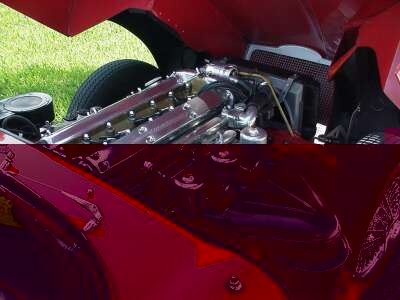
Series 1 and 2 : classic in line 6
XK engine, 3.8 or 4.2 litre
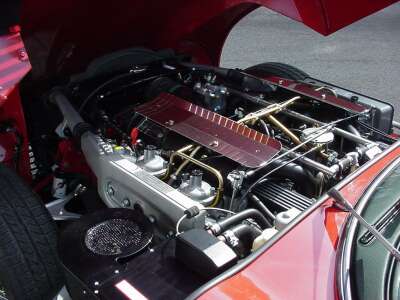
Series 3: mighty 5.3 liter V12
|
By 1969, with the installation of various emission control devices the
E-type had become the Series 2 which, when equipped with the dual carburetor
US spec engine, was starting to become low on power with a net rating
of only 175 hp… This explains why triple carburetors conversion and
elimination of some of the emission control system are sought after by
series 2 owners.
In parallel to the E-type struggling to meet tougher emission standards
and loosing performance in the process, Jaguar engineers had been working
on a V12 engine intended as an optional power plant for the new XJ6 saloon.
Once again, history repeated itself with Jaguar launching a new engine
designed for a saloon in a sports car, just like they had done with the
XK engine in 1948 and as they will do again with the AJ6 engine in the
mid eighties and even the V8 in 1996.
The V12 E-type turned out to be a comfortable, high performance and very
smooth car which restored all of the performance lost with the years.
Top speed was once again very close to 150 mph and 0 to 60 acceleration
was back down to just under 7 seconds. Very little was changed to the
interior but what was changed was not for the best… the stylish wooden
rim steering wheel was replaced by a leather version and the central leather
covered console and tunnel cover replaced with molded plastic… welcome
to the 70s...
In addition to the V12 engine, the E-type suspension was redesigned with
a wider track, wider tires and flared arches to accommodate the changes.
The 2 seater coupe was dropped in favor of the 2+2 and the convertible
was now built on the same longer wheelbase. Unfortunately to some, the
E-type lost some of its sports car character and evolved in a grand tourer.
After 13 years in production, and now facing not only competition from
more modern cars but the oil crunch of 1973, the last E-type rolled off
the assembly line in 1974. The last 50 E-types were all roadsters, painted
black and featured a commemorative dash plaque. Over 72 000 E-types had
been produced and Jaguar had permanently left its mark on automotive history
for the E-type is one of most recognized car ever manufactured.
Buying an E-type…
While the E-type is one of most recognizable classic car, it is not as
out of reach as it may seems. Yes, E-types are more expensive than other
British cars like MGs, Triumphs, etc… but some models / years can
be found for far less than other classics, yet be extremely enjoyable
to drive and admired.
Exact dollar value will vary from year to year but many decent solid
E-types can be purchased for the price of a small modern sports car or
medium sedan… think about this… driving an icon for the price
of a… Miata, S2000, MR2, etc… Obviously, $ 20 000 will not get
you a Concours winner roadster but it will put you behind the wheel of
a good Coupe or 2+2.
2+2s, with their higher roofline, are usually the cheapest E-types, especially
the 69s through 71s which, in the US, suffer from restricted performance
because of the pollution control efforts implemented at the time.
Roadsters are more expensive and you will have to spend at least another
$10 000 to enjoy top down motoring in a decent car, again not a restored
Concours winner…, but these are reasonable prices considering what
you’re getting.
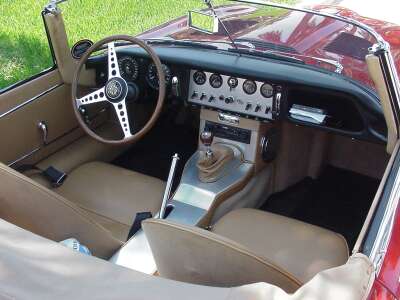
Series 1 interior : fixed buckets seats,
wood rim steering wheel, toggle switches and aluminum finsh on
the intrument panel and console.
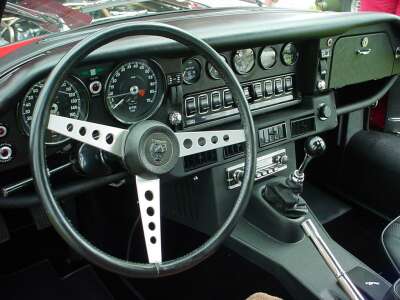
Series 3: Like the the series 2, the
aluminum trim is gone and it has adjustable seats with headrests
and rocker switches.The leather wrapped sterring wheel is unique
to the Series 3 along with the molded plastic tunnel cover which
replced the leather console found on the series 2.
|
Series 1 E-Types, with the covered headlights and original unmolested
styling are the most valuable especially the roadsters. Very early cars
with flat floors, outside bonnet latches, etc.… usually fetch a premium
and while the classic car market has not recovered for the early 90s tumble,
values have been on the rise and the very best specimens are consistently
selling near or above the 6 figure marks at high end auctions.
If you're thinking of buying an E-type as an investment,
you are mistaken although you are welcome to try this excuse to convince
your wife... and subtle use of key words like Enron, AOL, Nasdaq may actually
work like a charm. Although not an real investment, the value an E-type
is unlikely to go down and they may not be as bad as it seems; at least
you can take take you E-type for a ride and enjoy it... can't do this
with your Worldcom stocks... Compared to modern exotic sports cars, awell
cared for classic E-type will maintain its value, unlike its new counterpart
which will depreciate the minute it is driven off the showroom floor.
On the other hand, restoring an E-type is very costly and
like most other classic cars, you are far better off buying the very best
car within your budget rather than getting one in need of a complete restoration.
Parts are easy to get and can be reasonable… but there can be a lot
of parts needed… and lot of labor to put them on especially in the
body department.
Rust is the major concern on Jaguars, and particularly E-types because
of their monocoque construction where the body shell doubles as the structure…
no frame. Again, body panels can be found ( new or used ) but are expensive
to install. So it's no surprise that the first thing to check on any E-type
is rust especially in any structural area like the sills, rockers, firewall,
rear suspension mounting points. Any car that’s been sitting outside
for a while, especially unused, should be considered suspect and carefully
checked.
Another critical structural part are the engine rail frames which not
only carry the engine but also the front suspension. The material used
on the rail frames cannot be welded and must be replaced is cracked, rusted
or seriously dented…. Unless you don’t mind if your front suspension
collapses at high speed… Again, new frames can be purchased but they
are not cheap and the engine / suspension have to come out to change them…
The engines and transmissions are nearly bullet proof and can last a
very long time so mileage is not really a critical issue. Both the XK
and V12 engines are capable of achieving high mileage, although the V12
is a little more sensitive to damages resulting from overheating. If considering
a car with a past history of running hot… beware. There are 12 pistons,
2 cylinder heads, 24 valves, springs, etc... to replace or rebuild.
The rest of the systems (cooling, electrical, fuel, brakes, etc…)
are fairly reliable if properly maintained. Until the late 80s, E-types
were just used sports cars with fairly low values and as such were not
always maintained as they should have been, often their low values meant
people buying them couldn’t necessarily afford to maintain them.
This is also why some were converted to American V8 engines, lumps, a
cheap fix which drastically reduces the value of an E-type… Returning
them to their original configuration can be expensive and time consuming,
even though engines and transmissions can be found, because of the number
of parts that had been modified or discarded in the process.
Parts are readily available from a number of specialists, either used
or new. Some companies even specialize in upgrades ranging from brakes,
suspension, 5 speed conversions and performance engine modifications.
In most cases, quality and reversible performance upgrades do not have
a negative impact on the value of the car.
The number one advice given to anyone considering an E-type is to get
it inspected by an E-type specialist, or at least someone who knows these
cars very well. Past maintenance record are important too and take your
time, do not fall for the very first E-type you see… Patience and
discrimination are key in your search, walk away from a car if you don’t
feel comfortable about its condition or the seller...
Matching numbers (if verified) and original color are a plus toward the
value of an E-type but in most cases will not make a real difference compared
to overall condition. As always beware of fresh paint, which could hide
trouble spots just long enough for the Bondo to crack and rust to become
visible again... Automatic transmissions and steel wheels (on series 3
cars) do affect values negatively possibly by as much as $ 1000 each.
Driving and Maintaining
an E-type...
As with any other classic car, maintenance cost will be function of
the condition of the car and the type of driving done. It is not unusual
for new owners to spend some time going through their car system by system
coping with problems and failures, especially if the car they bought wasn’t
driven much. Sitting undriven for weeks at a time is the worst thing that
can happen to an E-type.
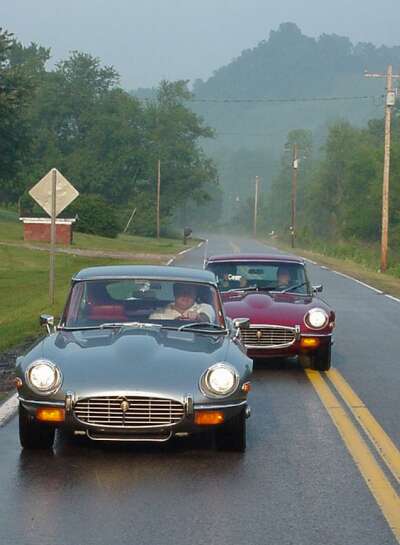 E-types are great drivers... from city
streets to highway cruising or carving through Tennessee backroads
as this pair of Series 3...
E-types are great drivers... from city
streets to highway cruising or carving through Tennessee backroads
as this pair of Series 3... |
If items like hoses and belts have not been replaced in a long time (
4, 5, 6 years or more…) you are probably better doing it in the comfort
of your garage than on the side of the road… Tires should also be
replaced every 5 years as rubber will deteriorate with age. Ignition,
charging and fuel pump/tank are also common cause of headaches on cars
that where not driven much and although fairly easy to troubleshoot it
can easily discourage a new owner.
The good news is that with little time, effort, and money once these
initial gremlins have been eradicated, there are really no reason an E-type
cannot be as reliable as a modern car. One thing is sure, they are much
more simple with no electronics, computers and other gizmos... A little
preparation, a few spares, tool and a service manual, will go a long way
if stranded somewhere... try that with a modern computer driven car !
Which brings us to the second most asked question : Can an E-type be
used as a daily driver ?
Sure… once sorted out these are very reliable cars, fun and somewhat
practical. The fun factor is obvious… E-types look great, and attract
a lot of positive attention… from envious looks to thumb ups wherever
you go. They are also excellent performers fully capable of dealing with
modern traffic... and more. The near supercar performance of the 60s may
have lost some of its shine 40 years later but an E-Type will still be
able to keep up with many modern cars, and do it in style.
Practicality is subject to personal interpretation… If you don’t
mind non power gadgets along with a little less comfort then you won’t
be disappointed. After all, these are 30 to 40 year old cars, from an
era where drivers where far less demanding from sound and heat insulation,
air conditioning and heater (climate control didn't exist back then),
etc.… However, these minor details are quickly forgotten and in most
cases, a well maintained E-type makes a great driver.
The adjustable seats found in the Series 2 and Series 3 cars are very
comfortable despite their age... I often drive my Series 3 on very long
trips (up to 15 hours or more) and never felt any cramps or backaches...
Which one is best as a daily driver ? The E-type was revised and improved
over the years so if you will spend a lot of time driving in real world
situations, the series 2 or series 3 might be a better choice because
of better brakes and cooling, more comfortable seats, etc.… although
some will argue that even the early series 1 are practical as well. The
2+2s shines as a daily driver thanks to their longer wheelbase making
it much easier to get in and out of them ! Of course, the rear seat in
a 2+2 is a plus, although too small for adults, they are perfect for kids
up to 10 to 12 years old… and it’s much cooler to be driven
to school in an E-type than in a minivan…
If daily driving isn't a consideration, then personal preference and
(unfortunately) budget considerations will define what you will long for.
Some prefer the narrow track look of the 6 cylinder cars, others like
the more muscular look of the flares and wider track found on the V12s.
The original XK engine will appeal to some, while others will want the
exotic V12 engine. Considering how few people will ever have the chance
of driving one, any E-type is a good choice !
Owning, maintaining and driving a 30 to 40 year old classic E-type might
not be for everyone but it is much easier than you may think.
For more information on the E-type, visit the Jag-Lovers
E-type site or the Jag-Lovers
E-type Forum
|











